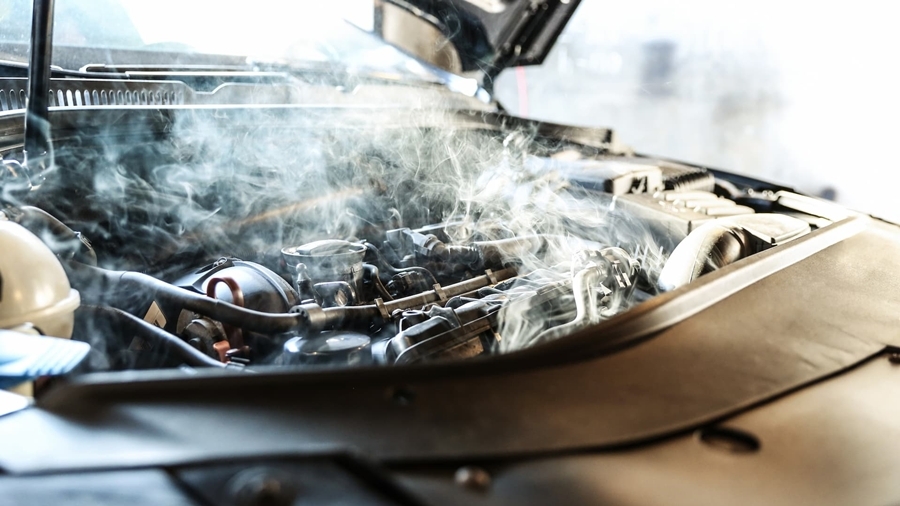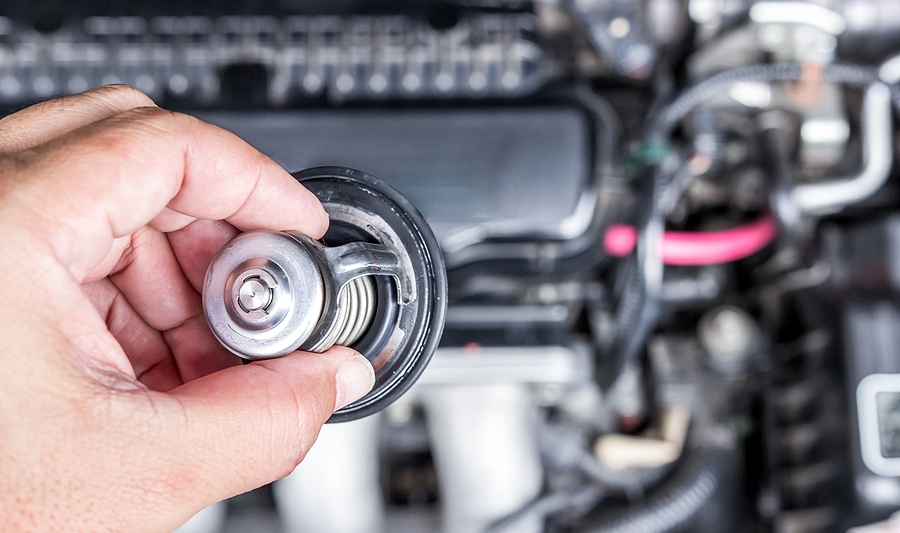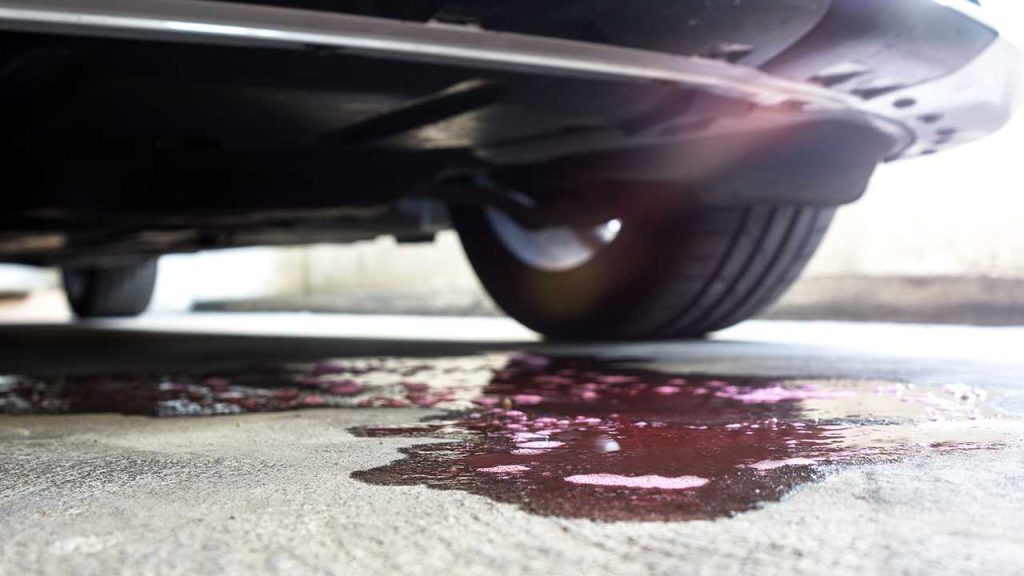Let’s face it – there’s nothing quite like that moment of panic when you glance down and see your temperature gauge creeping into the red zone. Your heart sinks as you spot steam billowing from under the hood. Yep, your car is overheating, and it’s not happy about it. In this post, we’ll discuss the burning question: why do cars overheat, what causes it, what you can do yourself, and when it’s time to find a mechanic.
Engine overheating is one of those car problems that’s impossible to ignore and genuinely scary when it happens. It’s not just an inconvenience – it’s your car screaming for help before something really expensive breaks. And it doesn’t just happen in summer; knowing why co cars overheat while driving is crucial year-round.
Key Takeaways
- Low coolant is the #1 culprit.
Whether from leaks, evaporation, or neglect, not having enough coolant prevents proper heat transfer. - Overheating symptoms are easy to miss — until it’s too late.
Watch for climbing temp gauges, steam, strange smells, or a sudden loss in engine power. - Where and when it happens matters.
Overheating at idle vs. on the highway often points to different issues (fans vs. radiator or thermostat). - Coolant type and quality matter.
Using the wrong type or mix — or skipping flushes — can lead to blockages and overheating. - Don’t ignore the fan, water pump, or radiator.
Mechanical failures here are silent killers, especially in stop-and-go traffic or extreme heat. - Driving while overheating can destroy your engine.
From warped heads to cracked blocks, the damage is often severe and expensive. - Prevention is cheaper than repairs.
Flush coolant regularly, check hoses and belts, and inspect the radiator — especially before long trips.
Also read: 7 Costly Mistakes to Avoid During Car Thermostat Replacement
Table of Contents
The good news? Most car overheating issues are preventable with a bit of knowledge and regular maintenance. And even when your engine decides to throw a temperature tantrum, knowing what to do can be the difference between a minor pit stop and a major repair bill.
In this guide, we’ll break down everything you need to know about why do cars overheat, what causes it, how to spot the warning signs, what to do when it happens, and – most importantly – how to stop it from happening in the first place. No mechanical engineering degree required!
How Your Car’s Cooling System Actually Works
Alright, let’s get down to basics. Your car’s engine is basically a controlled explosion machine, creating ridiculous amounts of heat – we’re talking over 2,000°F inside those combustion chambers! Without something to manage all that thermal energy, your engine would melt itself into an expensive paperweight in minutes.
Enter the cooling system – your engine’s personal temperature regulator. The concept is pretty simple: a special fluid called coolant circulates through the engine, soaking up heat like a sponge, then releases that heat into the air via the radiator. Then it heads back to the engine to repeat the process, over and over again.
Here’s what keeps everything running cool:
- Radiator: Think of it as your engine’s heat exchanger. Hot coolant flows in, cooler coolant flows out thanks to all those metal fins that transfer heat to the surrounding air.
- Water pump: The heart of your cooling system. This pump keeps the coolant moving. If it fails, the coolant can’t circulate – one of the top reasons why do cars overheat.
- Thermostat: The gatekeeper that controls coolant flow to the radiator. If it sticks shut, you’ll know exactly why your car is overheating.
- Cooling fan: Kicks in when you’re sitting in traffic or crawling along slowly, pulling air through the radiator when natural airflow isn’t enough.
- Hoses: These are the veins of the system, channeling coolant from one component to the next. Cracks or leaks here can quickly cause engine overheating.
- Expansion tank: This little reservoir gives the coolant space to expand as it heats up.
- Coolant/antifreeze: A mix of water and chemicals that prevent freezing and raise the boiling point – critical for keeping your engine cool in all driving conditions.
The whole system runs under pressure (around 15 psi), which raises the boiling point of the coolant so it can absorb more heat without turning into steam. When everything’s working properly, your engine stays at a healthy 195–220°F, whether you’re stuck in traffic or cruising down the highway.
Understanding your car’s cooling system is key to answering the question: why do cars overheat, especially why do cars overheat while driving or when sitting still. As we dig deeper, you’ll see just how many things can go wrong – and what you can do to stop them.

Why Do Cars Overheat? 12 Common Causes You Should Know
If you’re asking “why do cars overheat?” — you’re not alone. Engine overheating isn’t just frustrating, it’s a sign that something critical in your cooling system isn’t working right. Here are the most common reasons why do cars overheat, broken down into three key categories: fluid issues, mechanical failures, and external factors.
| Cause | Symptoms | Category |
|---|---|---|
| Low coolant level | Rising temp gauge, coolant light, no visible leaks | Coolant Issue |
| Old or dirty coolant | Sludge in reservoir, rusty color, foul smell | Coolant Issue |
| Wrong coolant mix | Overheating shortly after a coolant top-up | Coolant Issue |
| Faulty water pump | Coolant leak, whining noise, rapid overheating | Mechanical Failure |
| Stuck thermostat | Sudden overheating, no warm air from heater | Mechanical Failure |
| Clogged or bad radiator | Engine hot, radiator cool to touch | Mechanical Failure |
| Broken cooling fan | Overheats in traffic or at idle, fan doesn’t turn | Mechanical Failure |
| Extreme weather | Overheats in very hot conditions | External Factor |
| Heavy towing/load | Overheats going uphill or during acceleration | External Factor |
| Traffic conditions | Overheats while idling or stop-and-go driving | External Factor |
| Blocked radiator airflow | Debris on grille, temp climbs at higher speeds | External Factor |
| Failing radiator cap | Coolant overflow, fluctuating temperature gauge | Mechanical/Coolant Mix |
Coolant-Related Issues (The #1 Overheating Trigger)
1. Low Coolant Levels
This is the most common reason why do cars overheat. Without enough coolant, your engine can’t shed heat properly. Leaks, evaporation, or skipping scheduled maintenance can cause coolant levels to drop quickly.
2. Old or Contaminated Coolant
Like oil, coolant breaks down over time. Sludgy or acidic coolant can clog internal passages and even damage components, leading to poor heat transfer and rising temperatures. It’s a lesser-known but real contributor when asking why do cars overheat during normal driving.
3. Wrong Coolant Type or Mix
Mixing coolant types (like green vs. orange) or using plain water can compromise your cooling system’s effectiveness. The wrong mix can lower the boiling point or reduce corrosion protection—both of which can explain why do cars overheat unexpectedly.
Mechanical Failures That Cause Overheating
4. Faulty Water Pump
Your water pump circulates coolant throughout the system. If it fails, coolant doesn’t move — and the engine quickly overheats. Look for leaks, grinding noises, or overheating at higher speeds as early signs of why do cars overheat mechanically.
5. Stuck Thermostat
If your thermostat gets stuck in the closed position, coolant can’t flow to the radiator. This leads to a sudden spike in engine temperature, especially after the engine warms up. It’s one of the more abrupt reasons why do cars overheat even after short trips.
6. Clogged or Damaged Radiator
Bent fins, rust, or internal blockages prevent proper coolant flow and airflow. This weakens the radiator’s ability to release heat and can silently lead to overheating. If you’re wondering why do cars overheat without warning, this is a big one.
7. Broken or Non-Functioning Cooling Fan
Especially in traffic or at idle, your cooling fan is essential for airflow. If it doesn’t turn on due to a failed motor, relay, or sensor, the radiator can’t dissipate heat fast enough. This is a very common scenario behind why do cars overheat at red lights or in stop-and-go traffic.
External Conditions That Can Push Your Engine Too Far
8. Hot Weather
Extreme ambient temperatures reduce your cooling system’s efficiency. If your radiator or fan is already weak, scorching heat can push your engine into the danger zone. Many people find out why do cars overheat the hard way during summer road trips.
9. Heavy Towing or Hauling
Carrying or pulling heavy loads puts a bigger strain on the engine. More work = more heat. Without upgraded cooling components, this can easily cause overheating on hills or long drives, making it a clear answer to why do cars overheat under load.
10. Stop-and-Go Traffic
At low speeds, natural airflow through the radiator drops. If your cooling fan isn’t picking up the slack, the engine can overheat even though you’re barely moving. It’s another frustrating real-world example of why do cars overheat even when the car isn’t moving fast.
11. Blocked Airflow to the Radiator
Leaves, bugs, or debris stuck in the grille or radiator can restrict airflow. This might seem minor but can significantly reduce cooling performance, especially at highway speeds. It’s a small but sneaky reason why do cars overheat more often than people think.
12. Failing Radiator Cap
A worn or defective radiator cap can’t maintain system pressure. This lowers the coolant’s boiling point and may cause overheating and coolant loss — a sneaky cause many overlook when asking why do cars overheat repeatedly with no obvious leak.
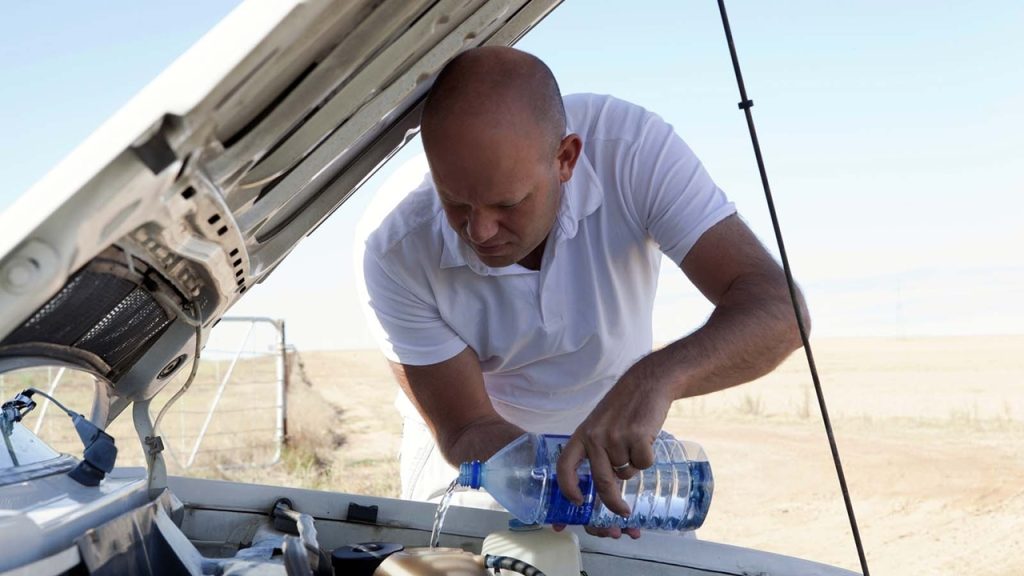
Warning Signs Your Car Is Getting Too Hot
The sooner you catch an overheating issue, the better chance you have of avoiding serious damage. When asking why do cars overheat, it often comes down to spotting these early red flags before things spiral into engine failure. Your car usually tries to tell you something’s wrong long before it melts down.
Dashboard Alerts
Temperature gauge climbing: That little gauge on your dash isn’t just for looks. If the needle starts creeping toward the red zone or “H” mark, your engine is screaming for help.
Warning lights: Many newer vehicles flash a temperature warning light or even display messages on the dash when your engine starts running too hot.
Check engine light: This one can mean a lot of things, but yes—overheating or cooling system failures are definitely on the list of reasons.
Physical Clues
Steam show: Seeing steam billowing from under the hood? That’s boiling coolant turning to vapor, which is a big clue into why do cars overheat while driving or idling. Pull over immediately.
Sweet smell: Coolant has a unique sweet scent. If you catch a whiff of syrup when your car is hot, there’s likely a coolant leak somewhere.
Colorful puddles: Spotted green, pink, orange, or blue liquid under your car? That’s probably coolant—and a leak like that is a top reason why do cars overheat in all kinds of conditions.
Engine acting weird: If your engine starts losing power, misfiring, or making ticking noises, that could be due to high engine temperature causing internal parts to expand more than they should.
Unusual sounds: Gurgling, hissing, or bubbling sounds from the engine bay often mean something’s wrong in the cooling system—one of the top answers to why do cars overheat unexpectedly.
Behavioral Clues
Constantly low coolant: If you’re regularly topping off coolant without visible leaks, it might be evaporating from overheating or going somewhere it shouldn’t—like into the combustion chamber.
A/C cutting out: When things get too hot, many cars will shut off the air conditioning automatically to relieve the engine load.
Heater not working: Ironically, when your engine is hot but your heater blows cold, it’s often a sign that coolant isn’t circulating properly.
Ignoring these signs is like ignoring chest pain—dangerous and costly. When engine temperature gets out of control, you’re risking blown gaskets, warped components, or worse.
My Car’s Overheating Now – What Do I Do?
You’re cruising along and suddenly the temperature gauge spikes or steam starts shooting out from the hood. Before panic sets in, know that how you react in the next few minutes can save your engine—and your wallet.
First Response Steps
- Turn off the A/C, turn on the heater: Sounds backwards, but blasting the heater pulls heat away from the engine. It might be uncomfortable, but it helps lower the risk of engine damage.
- Find a safe spot to pull over: If your temp gauge is in the red or you’re losing power, don’t push it. Pull over as soon as it’s safe.
- Shut the engine off: Letting a hot engine keep running is a guaranteed way to turn a small problem into a cracked block.
- Wait before popping the hood: Give it 15–30 minutes before you check things. Lifting the hood immediately can expose you to scalding steam and boiling coolant.
- Check coolant levels (carefully): When it’s finally safe, look at the coolant reservoir—not the radiator cap! If the coolant’s low, that’s likely why your car overheated.
What Not To Do (Seriously)
- Don’t remove the radiator cap when hot: This can cause serious burns. Only open it when the engine is fully cool.
- Don’t add cold water to a hot radiator: The thermal shock can crack the engine block—one of the worst outcomes of why do cars overheat episodes.
- Don’t keep driving: Being “almost home” won’t help when your engine is on the verge of total failure.
- Don’t restart without fixing the problem: Cooling it off without addressing the root cause means you’ll just overheat again.
When to Call in the Cavalry
You should absolutely call a tow truck or roadside assistance if:
- You’re in an unsafe location
- Steam is gushing out
- You’re unsure what you’re seeing under the hood
- Coolant disappears instantly after topping it off
- You’re in extreme weather that increases overheating risks
The Scary Stuff: What Overheating Does to Your Engine
Why do cars overheat may sound like a simple question, but the consequences of ignoring it are anything but. Even one major overheating incident can cause long-term engine damage or total failure.
The Damage Report
- Blown head gasket: This thin seal holds everything together. Extreme heat causes it to fail, mixing coolant and oil or pushing combustion gases into the cooling system.
- Warped cylinder head: Aluminum heads are especially prone to warping when overheated, ruining the seal and causing leaks, loss of compression, or misfires.
- Piston and cylinder scoring: Excess heat makes engine parts expand. If pistons expand too much, they scrape against the cylinder walls and can seize entirely.
- Cracked engine block: If you’re still wondering why do cars overheat while driving, consider this the nightmare scenario. Rapid, uneven heat expansion can cause the block to split—often making the engine beyond repair.
- Burned-out sensors: Sensors like the coolant temp sensor or oxygen sensor can fail due to excessive heat, leading to poor performance or false readings later on.
Signs of Major Overheating Damage
- White smoke from the exhaust (burning coolant)
- Bubbles in the coolant reservoir or radiator
- Milky oil (coolant in the oil system)
- Sudden power loss or rough running
- New leaks after an overheating event
- Compression issues or rough idle
The Financial Side
Overheating is more than just a mechanical issue—it’s a financial nightmare:
| Repair Type | Estimated Cost (USD) |
|---|---|
| Head Gasket Replacement | $1,500 – $2,500 |
| Cylinder Head Repair | $2,000 – $3,000 |
| Engine Rebuild | $4,000 – $8,000 |
| Engine Replacement | $5,000 – $10,000+ |
For older vehicles, these repairs often exceed the car’s value. That’s why it’s critical to understand why do cars overheat and act fast when the signs appear. Prevention, regular maintenance, and knowing what to do in the moment can mean the difference between a quick fix and a totaled engine.
Maintenance That Prevents Disasters
An ounce of prevention is worth a pound of cure—and when it comes to car overheating, that saying couldn’t be more accurate. Keeping your cooling system in top shape might not be glamorous, but it’s the cheapest way to avoid expensive engine repairs and roadside meltdowns. Knowing why do cars overheat in the first place is key to stopping it before it starts.
Regular Maintenance Checklist
- Coolant flushes: Don’t skip them! Follow your vehicle’s maintenance schedule—usually every 30,000 to 60,000 miles. Even long-life coolant breaks down over time and can cause buildup that contributes to car overheating.
- Pressure tests: A yearly pressure test helps catch leaks early, before they leave you stranded. Many repair shops include this during regular servicing.
- Inspect hoses and belts: Every oil change, take a quick look. Hoses should feel firm—not rock hard or squishy. Cracked or glazed belts? Time to replace.
- Radiator maintenance: Keep the radiator clean and clear of debris like leaves, bugs, and dirt. Blocked fins reduce airflow, making your car more prone to overheating.
- Thermostat replacement: If your car is approaching 100,000 miles (or you’re heading on a long trip), consider replacing the thermostat preemptively. It’s a small part that can cause a big problem if it fails at the wrong time.
Seasonal Smarts
- Summer prep: Before heatwaves hit, check your coolant level, radiator fan, and overall system health. Why do cars overheat more in summer? High ambient temperatures reduce the cooling system’s effectiveness, especially if something’s already failing.
- Winter prep: Make sure your coolant has the right mix of antifreeze to avoid freezing damage in colder climates.
- Road trip readiness: Long drive planned? Mountain roads? Towing? Let a mechanic inspect your cooling system first—you’ll be glad you did.
Owner Vigilance
Check coolant levels often: Add this to your regular routine, right alongside checking your oil.
- Fix leaks early: A small leak today can turn into a major coolant loss tomorrow.
- Use the right coolant: Not all coolants are created equal—use the type recommended by your vehicle’s manufacturer to avoid chemical incompatibilities.
- Listen closely: Unusual noises—like bubbling, hissing, or ticking when your engine is hot—might be early warnings of a cooling issue.
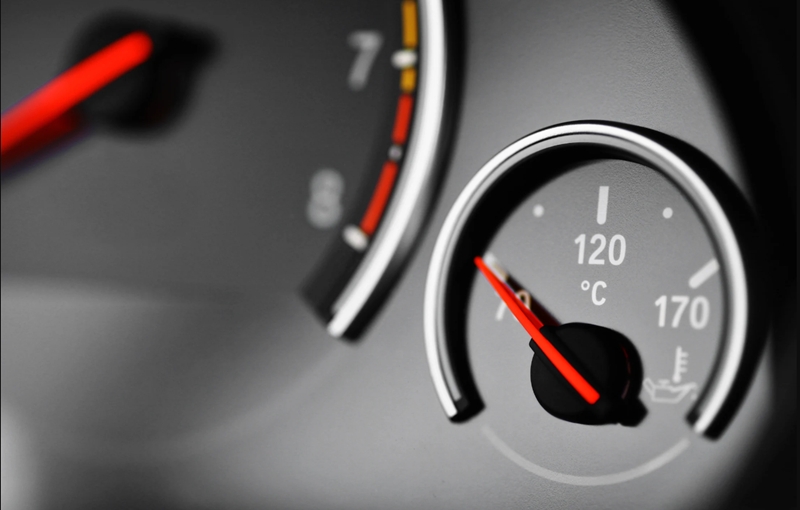
Figuring Out Why Your Car’s Overheating
Not all overheating is created equal. The pattern of when your car overheats can offer big clues about what’s going wrong. Understanding why do cars overheat in different driving conditions—like traffic jams, highway speeds, or uphill climbs—can help you zero in on the real issue faster.
| Symptom | Possible Cause |
|---|---|
| Temperature gauge rising | Low coolant, stuck thermostat, failing water pump |
| Overheats only at idle/traffic | Radiator fan not working, airflow blocked, low coolant level |
| Overheats only on the highway | Partially clogged radiator, weak water pump, stuck thermostat |
| Coolant puddle under car | Leaking hose, radiator, or water pump |
| Sweet smell inside the cabin | Leaking heater core |
| Steam from under the hood | Burst hose, blown radiator cap, or major coolant leak |
| Heater blowing cold air | Low coolant, air in the system, stuck-open thermostat |
| Gurgling or bubbling in reservoir | Air in system, blown head gasket |
| Rapid overheating out of nowhere | Broken belt, sudden coolant loss, failed water pump |
Overheating at Idle or in Traffic
If your car overheats while idling or in stop-and-go traffic but cools down when moving, likely culprits include:
- Malfunctioning fan: Electric or clutch-driven fans may not be activating when needed.
- Blocked radiator fins: Dirt or debris prevents airflow, especially at low speeds.
- Low coolant level: Just enough coolant for highway speeds, but not idle.
- Air pockets: Trapped air in the system can block circulation, especially in newer vehicles.
Knowing why do cars overheat in traffic often comes down to poor airflow or fan failure. These issues can creep up silently but become noticeable when the vehicle sits still too long.
Overheating on the Highway
If your car runs fine around town but overheats at highway speeds, you may have:
- Partially stuck thermostat: It opens, but not enough to meet higher demands.
- Failing water pump: Worn or corroded impellers reduce coolant flow.
- Clogged radiator internals: Rust or scale buildup inside the radiator restricts flow.
- Engine timing issues: Incorrect timing causes combustion inefficiencies that generate extra heat.
In cases like this, the question of why do cars overheat at high speeds is often answered by flow restrictions or a failing pump that can’t keep up with the demand.
Overheating Under Heavy Load
Does your car overheat while towing, climbing steep grades, or fully loaded?
- Undersized cooling system: Some vehicles have minimal cooling capacity from the factory.
- Transmission heat: Combined heat from the transmission (especially if it shares the radiator) can overwhelm the system.
- Slipping belts: Worn belts may not spin the water pump effectively under load.
- Air in the system: Any trapped air can limit coolant circulation during heavy demand.
Sudden Overheating Out of Nowhere
If your car goes from normal to redline in moments, something major likely failed:
- Coolant loss: From a burst hose, cracked radiator, or failed gasket.
- Water pump failure: If the pump stops spinning, coolant stops flowing.
- Broken belt: If your water pump runs off the timing or serpentine belt, it can fail without warning.
- Road debris: A rock or object can puncture a radiator or smash a cooling fan.
Most drivers will face an overheating episode at some point—but it doesn’t have to end in a disaster. With proper maintenance, modern tech, and a little attention to early warning signs, you can keep your cool (and your car’s engine cool too). Whether you’re prepping for a road trip or just sitting in city traffic, understanding why do cars overheat gives you the power to stop it before it starts.
Common Causes of Cooling Fan Failure
1. Blown fuse or bad relay – Cuts power to the fan entirely.
2. Faulty temperature sensor – Fan never gets the signal to turn on.
3. Burned-out fan motor – The fan itself is dead.
4. Wiring issues – Loose, corroded, or broken wires disrupt power flow.
5. Fan control module failure – On modern cars, this electronic unit can go bad.
6. Clutch fan failure (older vehicles) – The mechanical clutch stops engaging properly.
DIY or Call a Pro? Cooling System Repairs Made Simple
Some cooling system fixes are well within reach of a confident DIYer, but others? Best left to the pros. Here’s a clear breakdown so you don’t bite off more than you can wrench.
DIY-Friendly Jobs
If you’ve got some tools and don’t mind getting your hands dirty, these tasks are usually manageable at home:
- Topping off coolant: Check the reservoir and add pre-mixed coolant if needed. Easy win.
- Visual inspections: Look for leaks, cracked hoses, and signs of a radiator fan not working — like overheating when idling.
- Replacing the radiator cap: A simple twist-and-swap that can solve pressure-related overheating issues.
- Thermostat replacement: On many cars, it’s just a matter of unbolting and replacing with a fresh one.
- Hose swaps: As long as the engine is cool, changing out worn hoses is a straightforward task.
- Belt replacement: If your car’s water pump is belt-driven, replacing the accessory belt is often DIY-friendly.
- Coolant flushes: With a commercial flush kit and some patience, this is totally doable — and helps prevent the common problem of why do cars overheat due to old, contaminated coolant.
Jobs Best Left to a Mechanic
Some cooling system repairs require special tools, experience, or access only a pro can handle:
- Water pump replacement: Often buried deep in the engine, sometimes involving timing components.
- Radiator replacement: Sounds easy, but bleeding the system and dealing with transmission coolers can get tricky.
- Head gasket work: Major engine surgery — not something to attempt without serious experience.
- Electronic component repair: Diagnosing a radiator fan not working due to wiring or control module failure needs scan tools.
If you’re unsure, trust your gut — better to pay for a fix than cause bigger problems, especially when dealing with issues related to why do cars overheat unexpectedly.
Cooling System Repair Costs (DIY vs. Pro)
| Repair | DIY Cost | Professional Cost |
|---|---|---|
| Thermostat Replacement | $15 – $100 | $200 – $400 |
| Hose Replacement | $20 – $100 each | $150 – $300 |
| Radiator Cap | $10 – $35 | Usually included in service |
| Radiator Flush Kit | $30 – $100 | $100 – $200 |
| Water Pump Replacement | – | $400 – $1,000 |
| Radiator Replacement | – | $500 – $1,000 |
| Head Gasket Repair | – | $1,500 – $3,000+ |
Note: DIY costs include parts only. Professional prices include labor and vary by vehicle type, location, and shop rates.
Safety First!
Working with your cooling system? Keep these essential safety tips in mind:
- Dispose of old coolant safely — never pour it down the drain; recycle it at an auto shop or hazardous waste facility.
- Never open the radiator or reservoir when hot — it’s dangerous and can cause sudden pressure changes, one reason why do cars overheat unexpectedly.
- Wear gloves and goggles — coolant is toxic, slippery, and harmful on contact.
- Clean up spills immediately — especially if pets are nearby, since coolant is sweet-smelling but deadly.
- Always bleed the system properly — trapped air is a common reason why do cars overheat even after topping off coolant.
Need a mechanic? Find one on the Mobile Mechanic Directory
Why Do Cars Overheat: Wraping Up
Your cooling system might not get as much attention as flashy mods or detailing, but ignoring it can cost you thousands. Preventive maintenance, quick action when the radiator fan’s not working, and smart repair decisions go a long way.
Remember:
- Know what’s normal for your car.
- Act early when issues arise.
- Use the right coolant and parts.
- Don’t be afraid to call a pro when needed.
Understanding why do cars overheat gives you the power to prevent it. Whether it’s a small leak, a failing fan, or a deeper mechanical issue, spotting trouble early is everything. Learning why do cars overheat also helps you recognize patterns and fix issues before they escalate.

